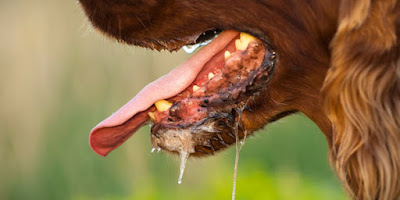The Rabies - A Guide To Know
However, today we have much more
powerful medical facilities for fight against disease but rabies has beer and
is still regarded in all parts of the World as one of the most terrifying
disease known to man and certainly as the disease causing the most terrible
death.
All warm blooded animals are
susceptible to rabies; but according to the World Health Organisation`s expert
committee on the disease, ‘not all animals are equally susceptible. The most
highly susceptible are foxes, coyotes, jackals, and wolves, kangaroo rats,
cotton rats and common field voles’.
Dogs are listed as only moderately
susceptible; but dogs are without any doubt the animals most likely to spread
the infection to human beings. In man, if one is infected then one of the manifestations
of the infection is –‘inability to swallow liquids, that`s why it has given the
disease the name -> Hydrophobia. Since the development of symptoms in man is
sufficiently different from that in other animals, hydrophobia is a term used
only to describe the disease in human beings.
The rabies virus belongs to a group of
viruses which are described as bullet-shaped or bacilliform. These viruses are
called rhabdoviruses. Recent research has shown that rabies virus is a
bullet-shaped particle containing RNA, Protein, Lipid and Carbohydrate. The
virus is able to infect all warm-blooded animals. In man, it is a severe
inflammation of the brain and spinal cord (encephalomyelitis) associated with
invasion of these tissues by rabies virus. It is virtually always fatal.
Rabies infection in man is nearly
always the result of a bite by an animal which has the virus in its saliva.
Virus cannot penetrate unbroken skin but even a lick by an infected animal can
be dangerous if the skin is grazed or damaged in some other way. Rabies virus
can enter the body through the intact mucous membrane such as the conjunctival
membrane covering the eye or the membranes lining the mouth, anus and external
genital organs.
Assessment of the risk of developing
the disease after a bite is one of the most difficult problems in the study of
rabies. Unless the biting animal can be examined it is not possible to be
certain whether the patient was even exposed to the risk of infection. If
rabies virus is present in the saliva of the animal it can be assumed that the
patient was infected (i.e. virus entered the body) but, even without any
treatment, the patient may not develop rabies. The reason may be that
insufficient numbers of virus particles were inoculates or that the body`s own
defences were able to inactivate the virus before it could get into a nerve and
start its ascent to the brain.
The risk of developing disease after
infection from rabies virus is increase with the severity of the bite. The
greater the tissue damage the greater the chance of virus being able to enter
nerves. Bites on the face carry the highest risk. The face has a rich nerve
supply and its soft tissues are easily disrupted. Facial bites are associated
with a very short incubation period, allowing less time for vaccine to
stimulate the antibodies necessary to neutralize rabies virus before it can
enter the nervous system.
The saliva, tears, sputum and other
body secretions of human rabies victims contain rabies virus for about the
first week of their illness.
“Most of us familiar with the stories of
fictional or mythological creatures like – Vampires. Their way of transmission
of vampirism is same as rabies virus transmission in some extend. And because
rabies infected people have some behavioural changes, so may be in past
centuries, people take effect of rabies virus as some supernatural power or
evil power; and because of this a new stream of vampire literature was became
famous. But in reality there was or are no creature exist whom we call
“Vampire”.
Anyway let`s come on our topic, so the
first sign that treatment has failed to prevent rabies virus invading the
central nervous system is often a vague feverish illness. The patient feels
generally unwell with loss of appetite, headache and other aches and pains,
weakness, tiredness and fever. The symptoms may resemble influenza, a common
cold or a sore throat. Rarely there are more severe symptoms of a chest
infection including cough. Patients who know that they have been exposed to
rabies will naturally become anxious and apprehensive when they fall ill a few
weeks or months after the bite, but a change in mood is often noticeable as an
early symptom even in those who have not appreciated the threat of rabies.
Restlessness, depression, a feeling of
tension, a sense of foreboding, nightmares or inability to sleep and lack of
concentration have all been described.
None of these features is diagnostic
or even particularly suggestive of rabies. The majority of patients develop a
symptom which is, however, highly suggestive of impending rabies. They feel an
abnormal sensation radiating from the site of the bite wound, which by now will
have healed, numbness, tingling (pins and needles), itching, coldness, burning,
stabbing pain, or aching may be experienced in association with trembling or
weakness of the affected limb. These prodromal symptoms, which are the prelude
to the illness proper, last for a few hours to a few days.
India has the highest rate of human
rabies in the world, primarily because of stray dogs, whose number has greatly
increased since a 2001 law forbade the killing of dogs. Effective control and
treatment of rabies in India is hindered by a form of mass hysteria known as
puppy pregnancy syndrome (PPS). Dog bite victims with PPS, male as well as
female, become convinced that puppies are growing inside them, and often seek
help from faith healers rather than medical services. An estimated 20,000
people die every year from rabies in India, more than a third of the global
total.

















Comments
Post a Comment